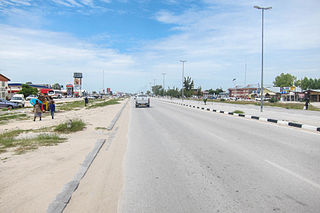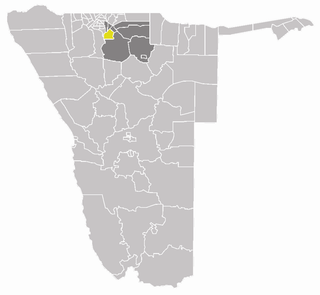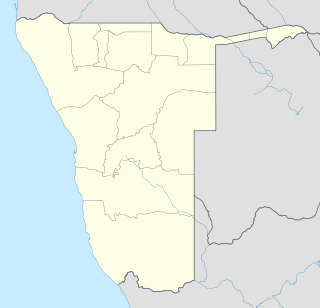Education in Vietnam is a state-run system of public and private education run by the Ministry of Education and Training. It is divided into five levels: preschool, primary school, secondary school, high school, and higher education. Formal education consists of twelve years of basic education. Basic education consists of five years of primary education, four years of secondary education, and three years of high school education. The majority of basic education students are enrolled on a daily basis. The main education goal in Vietnam is "improving people's general knowledge, training quality human resources, and nurturing and fostering talent."

Education in North Korea is universal and state-funded schooling by the government. The self-reported national literacy rate for citizens at age of 15 and older is 100 percent (approx.). Children go through one year of kindergarten, four years of primary education, six years of secondary education, and then on to university.

Ondangwa is a town of 23,000 inhabitants in the Oshana Region of northern Namibia, bordering Oshikoto Region. Ondangwa was first established as a mission station of the Finnish Missionary Society in 1890. In 1914 it became a local seat of government.

Otjiwarongo is a city of 28,000 inhabitants in the Otjozondjupa Region of Namibia. It is the district capital of the Otjiwarongo electoral constituency and also the capital of Otjozondjupa.

Adityapur is an industrial city/ sister city of Jamshedpur, and a nagar parishad in the Seraikela Sadar subdivision in the Seraikela Kharsawan district of Jharkhand, India

Education in Ethiopia was dominated by the Ethiopian Orthodox Church for many centuries until secular education was adopted in the early 1900s. Prior to 1974, Ethiopia had an estimated illiteracy rate below 50% and compared poorly with the rest of Africa in the provision of schools and universities. After the Ethiopian Revolution, emphasis was placed on increasing literacy in rural areas. Practical subjects were stressed, as was the teaching of socialism. By 2015, the literacy rate had increased to 49.1%, still poor compared to most of the rest of Africa.

Education in Namibia is compulsory for 10 years between the ages of 6 and 16. There are approximately 1900 schools in Namibia of which 100 are privately owned. Namibian subjects' syllabi are based on the International General Certificate of Secondary Education which is part of Cambridge International. The Constitution directs the government to provide free primary education; however, families must pay fees for uniforms, stationery, books, hostels, and school improvements.
Education in Eswatini includes pre-school, primary, secondary and high schools, for general education and training (GET), and universities and colleges at tertiary level.
Johannes Kamati Nakwafila is a Namibian politician. A teacher by profession, he has been a member of the National Council of Namibia since 2004 and Regional Councillor for Epembe Constituency since 1999.
Samuel Abraham Peyavali "Peya" Mushelenga is a Namibian politician and poet.

Omuntele Constituency is an electoral constituency in the Oshikoto Region on the northern part of Namibia. It has 21,884 inhabitants. The district capital is the settlement of Omuntele.

Onayena Constituency is an electoral constituency in the Oshikoto Region of Namibia. It has 15,684 inhabitants; its district capital is the settlement of Onayena. Currently the Councillor of Onayena is Mr. Mateus Nelumbu Kamati, a former SWAPO Coordinator in the Constituency. The Constituency's population has grown significantly over recent years, dominated by the Ovambo language speaking people and a small group of San people.
Education in South Sudan is modelled after the educational system of the Republic of Sudan. Primary education consists of eight years, followed by four years of secondary education, and then four years of university instruction; the 8 + 4 + 4 system, in place since 1990. The primary language at all levels is English, as compared to the Republic of Sudan, where the language of instruction is Arabic. There is a severe shortage of English teachers and English-speaking teachers in the scientific and technical fields.

Nehale lya Mpingana was Omukwaniilwa of Ondonga, a subtribe of the Owambo, in German South West Africa. Their tribal area is situated around Namutoni on the eastern edge of Etosha pan in today's northern Namibia. He reigned over the eastern part of the Ondonga area from 1884 until his death; Kambonde II kaMpingana was chief of the western part.

Windhoek International School is an independent, co-educational, international school located in Windhoek, Namibia. The school provides education from Early Years 1 through to Grade 12. It offers the IB Primary Years Programme and IB Diploma Programme as well as the International General Certificate of Secondary Education. As an IB World School it is the only school in Namibia to offer International Baccalaureate programmes and is the one of the first schools worldwide to be authorised to offer these programmes. The school also boasts an international community of students from 45 different countries. Unlike other schools in Namibia, the International School's school year runs from mid-August to mid-June.

Onayena is the district capital of Onayena Constituency north of Oshikoto Region in northern Namibia, situated approximately 80 kilometres (50 mi) north of Etosha National Park.
Elizabeth Magano Amukugo is a Namibian politician and academic with the University of Namibia.

Culture in Namibia is a blend of many different people and its culture and customs have absorbed both African and European elements and fused them into a blend of the two. Although the country is urbanising rapidly, a majority of Namibians still live in rural areas and lead largely impoverished lives. It is among these people, however, that cultural tradition survive most strongly.












